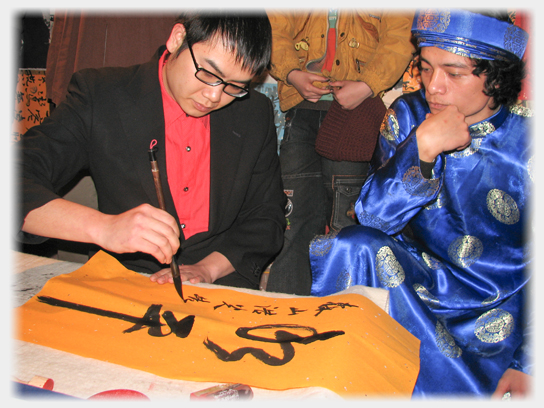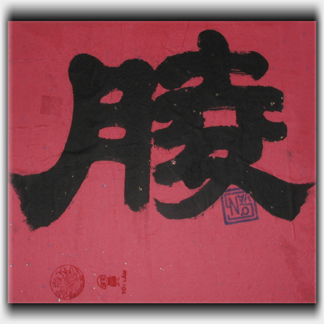
|
Nôm
Some social events have impressive ingredients. The opening of the exhibition of Nôm art at which this photograph was taken is one such. Here modern Vietnamese culture is seen combining, in one event: performance art, fine art, calligraphic art, languages and semantics. At the centre of this complex of arts lies Nôm (Lê, 1989). the old written form of the Vietnamese language, the great literary wealth of which, in tens of thousands of books, is now only accessible to a few scores of scholars. Recent history has meant that these treasures have been neglected, but now Vietnam's burgeoning economy offers hope for rescue.
As Nôm has an ideographic core to its script, it can join in the Eastern tradition of calligraphic art for which we sadly lack an equivalent in the West. This lack of a corresponding genre means that the artists in the picture are performing in a way that is complex to translate, just as it is it is complex to translate the work of poet artists such as Basho. A little further understanding of the place of Nôm in Vietnamese culture may help see the relationships more clearly, and so contribute to unravelling some of tangled processes involved where thought and language meet.
Nôm's origins date from about 1,100 years ago when it was developed as the written language of Vietnam; that was during the time of the Chinese occupation. Then "big brother's" system (civil service, laws, literature and philosophy) was the only system allowed in Vietnam. So Chinese culture and language became totally intertwined with native Vietnamese forms. Today, due to that history, more words of Vietnamese have Chinese origins than are indigenous; very much as English contains more French, than Old German, because of the events of a 1,000 years ago. Because Vietnamese has its roots in Mon-Khmer and Thai there were sounds which could not be transliterated into the Chinese script. This meant that officials, who had to keep records, sometimes found it difficult to represent the names of places and people. And further, the official language was just that, rather official, and in comparison to Vietnamese, bad at conveying emotions, and social and personal events.
So Nôm, a written form of the Chinese language, was developed to cope
 with these difficulties. In many cases a Nôm character was created by adding another element to the normal Chinese, indicating a particular Vietnamese sound. Here we can see the
Chinese character for moon
on the left, but now with an added element to create the Vietnamese version of the concept.
with these difficulties. In many cases a Nôm character was created by adding another element to the normal Chinese, indicating a particular Vietnamese sound. Here we can see the
Chinese character for moon
on the left, but now with an added element to create the Vietnamese version of the concept.
So in Nôm an element, the meaning of which was available to all readers, had added to it a phonetic element, understood by the speakers of a particular language. The example of moon is exceptionally simple, more normally the accretions were many and complex: an original element may have a couple of Chinese additions, to elaborate the meaning, and then a further addition to adjust this for a particular group of readers.
The final result required great effort and much time to master, and so it was not surprising that, a hundred years ago when social and political pressures also conspired, the Roman script replaced Nôm which was then largely forgotten. This conversion rendered Vietnamese writing totally phonetic: following a few simple rules today we can all read Vietnamese, although without any inkling of what we are saying! In China it took somewhat longer to make the official change which was published as Pinyin by the government in 1958 replacing the still familiar unofficial Wade-Giles system of 1912.
So the picture shows a piece of performance art (then novel to audiences) by scholar artists (the performers are postgraduates in the department of Nôm studies) for a modern audience (largely unfamiliar with ideograms) in which the calligraphy is understood in the context of an ancient art form (Eastern Calligraphy–familiar to the audience), and has meanings that are concrete, as in moon above, that have linguistic elements from Chinese languages (as unintelligible to the audience as they are to us), and linguistic elements from their own language (which could be explained to that audience). So in the picture above a single brush stroke links sound, meaning, art and culture.
References
- Lê Văn Quán (1989) ’Tự Học Chữ Nôm' Nhà Xuất Ban Khoa Học Xã Hội, Hà Nội, Vietnam.
30th September 2012 ~ 2nd October 2015